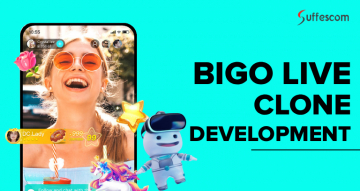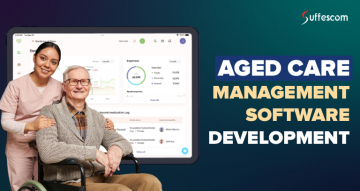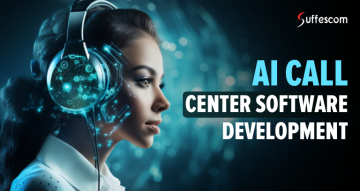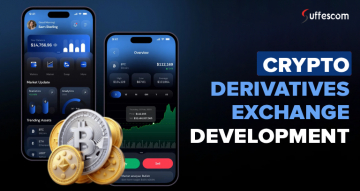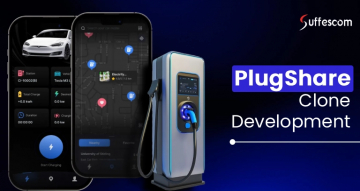AI Sports Training Coach Development | AI Solutions For Sports
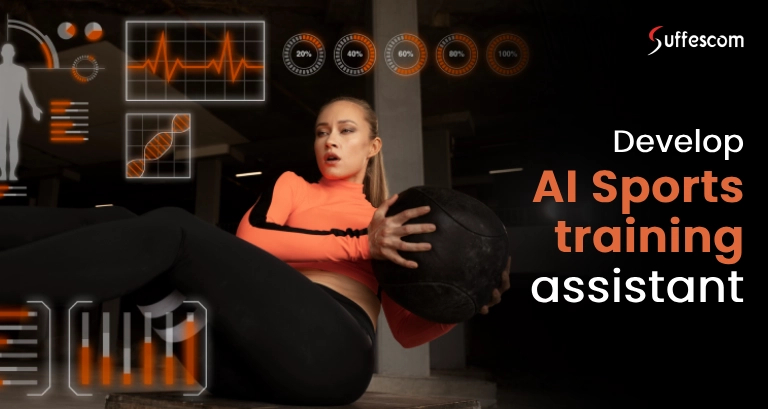
AI sports coaching assistant development solution includes real-time sport performance, customized training plans, biomechanical assessment, and injury prediction. AI provides a deeper level of detail about the athlete's biomechanical output, performance, and user history, which allows for more precise feedback more efficiently than a normal coach.
AI sports coaching assistants analyze videos, sensor outputs, and past performance records and feedback to serve as an additional resource in times when no personal or team coaches are present.
The need for data-driven solutions is accelerating across the sports spectrum. Businesses are constantly evaluating data from the sports ecosystem to guide their investment decisions in AI sports training app development. The craze is due to the AI integration in sports, which has transformed how athletes used to train and perform.
Why is there a Growing Demand to Develop AI Sports Training App?
The drive to develop AI sports training apps is linked to the larger demand for personalized, data-centric, and scalable athletic training. Often, the precision and replicability in traditional coaching or training cannot pinpoint the nuanced precision/course of performance each athlete must target, particularly when the program is run at scale.
The market size of AI in sports is expected to be valued at $4.7 billion by 2034, with a CAGR of 14.7% (2025 – 2034).
The AI Sports training tool development enables the automation of numerous critical coaching events while providing athletes and trainers with real-time guidance based on biometric, motion-related, and behavioral information. This is particularly advantageous in youth development programs, remote coaching arrangements, and even professional sport environments where performance differences can be fractions of a second.
Advantages of an AI sports Coaching App Development
- Recurring revenue model via AI-driven coaching subscriptions
- Increase user engagement through personalized journeys related to training
- Pathway for faster product scaling with the coaching automation
- Essential data collection for analytics and future development
- Partnerships with sports federations, bodies, gyms & fitness centers
AI Sports training app development: Future-Proof Your Business with Us!
Working Model of AI Sports Training App
1. Data Collection: The app collects data using smart devices and sensors from user movement, heart rate, distance travelled and fatigue. The application uses computer vision and motion analysis algorithms to automatically detect posture mistakes.
2. Immediate Feedback: The application will provide an immediate cue, whether it be a visual overlay, text prompts, or voice prompt, during the session, ensuring users improve technique throughout, thus reducing risk of injury and increasing efficiency.
3. Adaptive Personal Training Plans: The application uses artificial intelligence, to develop personalized workouts that evolve based on performance, fatigue, and missed sessions.
4. Progress Monitoring and Prediction: The dashboards show metrics for predicting risk of injury based on trends in heart rate variability, workload, and patterns of movement as predictive analytics.
5. Virtual Coaching and Motivation: With chatbots or voice assistants, queries are resolved that are usually asked of the coach.
6. Progress Monitoring and Prediction: The dashboards show metrics for predicting injury risk based on trends in heart rate variability, workload, and movement patterns.
How to Build AI-powered Coaching Platform?
1. Establish the Use Case
Before you begin the development process, conduct thorough research on the sport or training domain, audience types and the key problems the platform will address. Understanding what users seek ensures your AI coaching platform will be built for a purpose, not technology's sake.
2. Data Collection
AI models are only as good as the data they can trust to provide sound insights. The data must be collected and can include motion data, biometrics, video footage, lucid sensor input, or user input. The data must be labeled, structured, and preprocessed in some manner to develop AI models effectively.
3. AI Models Creation
Build custom AI model that streamlines complex tasks, helps make precise decisions, and gets deep insights about customer behavior.
- Computer vision for movement tracking and form correction
- Predictive models for predicting injury risk, performance, etc.
- Recommendation systems for training prescriptive plans
AI frameworks such as TensorFlow and PyTorch are used to develop models tailored to project needs and test them in real-life scenarios.
4. User Interface
A user interface refines complex insights into actionable information. The features include dashboards, visual feedback, video playback with AI overlays, and voice/chat assistants. All these elements amplify the user engagement and build interaction.
5. IoT Devices Integration
To add richer data and insights, potentially integrate with wearables or IoT sensors. Simply use the appropriate APIs to stream real-time data into the app for live coaching feedback and biometric data.
6. Regulatory Compliance
The AI powered coaching platform is subject to regulation from external regulatory bodies, such as GDPR and HIPAA. Solid encryption and storage in the cloud, as well as consent, are critical to comply with regulations, earn the trust of the users, and protect valuable user data.
7. Test, and Iterate
Based on the feedback of the real athletes and coaches, improve the accuracy of the AI, address usability issues, and refine the coaching suggestions. This is the only way to ensure that your 'solution' is effective and validated by the coaches themselves.
8. Launch And Scale
After the platform is validated, launch the app for public use. Select B2B partner opportunities with gyms, teams, clinics, or federations to develop a pathway for scaling adoption across target markets. With all the information and insight directly from the athletes and coaches, refine your AI models, engage with real-time data, and continue to use the collaboration as an opportunity to improve the effective use of your platform.
AI Sports Coach App Development: Features Delivering Overall Platform Success
1. Personalized Training Plans
AI leverages personal information, including fitness level, fitness goals, injury history, and wearable metrics, to help develop specific programming goals that adapt as progress is made.
2. Real‑Time Feedback
AI systems provide real-time feedback using computer vision coupled with either wearables or smart cameras observing movements during physical activities. The platform provides immediate reminders for correcting errors, which can reduce the risk of injury and improve movement technique.
3. Recovery Optimization
AI sports training app utilize biometric data, sleep data, fatigue data, and performance to assess training load and readiness for training in real-time. It also helps in adjusting the training session when a critical threshold is reached in terms of load or readiness.
4. Gamification & Tracking Dashboards
AI sports training apps use gamified incentives like badges, streaks, milestone celebrations, and challenges to promote sustained engagement. It develops progress through measurement over time through interactive dashboards such as player match appraisals.
5. Injury Prevention
AI sports coaching applications reduce injury by measuring biomechanics and observing levels of physical effort, as well as recognizing patterns to identify injury risk. The use of wearable sensors to record movement and computer vision technology acquires data on an athlete's consumption of loads and physiological measures in real-time.
6. Fan Engagement
AI in sports coaching assistants use real-time data and predictive analytics to create personalized multimedia in a sports fan engagement app, such as player stats, highlight videos, future game predictions, and other interactive experiences, all while watching a live match.
7. Scouting and game strategy
The platform identifies players and coaches using historical data and match video, along with tactical awareness through trend analytics and situational performance analysis. An AI sports betting app allows the AI models to gather massive data that leads to predicting the player's performance and the desired outcomes in a shorter time.
Popular AI Sports Training Apps We Develop
1. Humango
Humango is an AI-powered training app catered for athletes such as runners, cyclists & swimmers. The app uses AI to build personalized and adaptable training plans. The app tracks training data and user-collected data, along with considerations concerning load and recovery systems, to continuously adapt and improve the training programs.
2. TriQ
TriQ is a triathlon training app ideal for triathletes because it can automatically create training plans specified to a person's fitness level, race goals, availability, and training history. The unique attribute of the app is that it has an auto-adaptive system that modifies the weekly schedule in real time based on a noted change in performance metrics.
3. 2PEAK
2PEAK is an AI-powered sports training app designed for endurance (cycling, running, swimming). The app adjusts planned workouts and sessions based on current fitness levels, recovery state and race targets. This AI personal coach analyzes the recovery capacity and, therefore, evaluates the optimal training load.
4. TriDot
TriDot is a performance-optimized triathlon training system that uses big data analytics, machine learning and athlete feedback for optimal current and future training. The app focuses on maximizing efficiency in training and accurately predicting performance outcomes. It also provides amplified details on performance, training efficiency and injury risk.
How Much Does it Cost to Build AI-Powered Coaching Platform?
The estimated costs of creating an AI sports coaching assistant can range from $10,000 - $30,000, depending on many factors. Costs can vary due to complexity of the project, technology stack used, amount of data required, experience of the development team, and any deployment needs. Below, we have mentioned the factors affecting AI development cost;
1. Scope and Features
Feature set means everything, the cost to build a basic AI coaching mobile app which does video analysis, voice input, and performance tracking. However, if the app has later-stage features such as motion analysis in real time using computer vision and algorithms, the cost will rise . All this due to integration of advanced functionality such as training plans, biometric data, and feedback based on AI algorithms.
2. AI Model Development
Implementing solid AI models can involve a great deal of expense. Using pre-trained models (i.e., OpenPose for motion detection) can moderate expenses; however, developing new models for specific athletes or sport contexts requires:
- Data collection and labelling
- Training and tuning models
- Continuous learning and AI model updation
3. Data Collection
Obtaining raw data is the heart of any AI training assistant; without these inputs, their respective models would struggle to perform effectively. Sports-specific data is notoriously hard to get and expensive to label, especially with video datasets. Given those hurdles, purchasing naturally occurring data, along with your own data gathering using proprietary cameras and/or sensors, substantially increases the cost.
4. Platform and Technology Stack
Creating a cross-platform solution will have greater up-front costs; however, it will also offer a more significant potential customer reach. In addition, there are cost-impacting decisions around cloud versus on-premises solutions, backend architecture, and wearable device integrations .
5. Support & Maintenance
The post-launch activities also add up to the development budget. The ongoing costs include server environment and hosting, addressing bugs, retraining of the AI model, and addressing user support.
Future Trends Related to AI Sports Training Tool Development
The future of AI Sports training app development will transform the way athletes train, play, and then recover. The major trend involves personalized training programs, collecting various individual data such as biometrics, training history, recovery patterns, and even sleep and nutrition patterns to produce completely individualized workouts. Personalized workouts will assist athletes in training as efficiently as possible, reducing potential overtraining and helping mitigate injury occurrences.
Following this, the other major trend has to be real-time performance analysis. AI-powered performance analyzer uses computer vision combined with wearable sensors, where athletes' movements can be tracked by AI with a high level of accuracy. AI sports coaching assistant development will allow the coaches and athletes to gain real-time feedback with respect to the athlete's technique, like how they play, posturing while performing, which helps them instantly make corrections, resulting in continuous improvements.
AI models can analyze patterns in training loads, muscle fatigue, and movement abnormalities to predict injury risk. AI systems assist rehabilitation journeys by designing recovery programs as athletes progress relative to their rehabilitation recovery schedule, ensuring a safe return to full performance without injury. On the whole, AI will provide injury prevention and rehabilitation facilities without any hassle.
Lastly, AI virtual coaching is also emerging as a trend, particularly in individual sports. Virtual coaches are intelligent systems that provide athletes with training programs, guidance, track progress, and motivation, without the intense level of continuous human interaction. This is valuable as it allows high-quality training to be widely used in remote or lower-resourced areas.
Build AI-powered Sports Coach
How Does an AI Sports Training App Make Money?
1. Subscription Plans
Allows the users to pay a recurring fees i.e monthly or yearly to the platform owners to gain access to the premium features, resulting in a stable and predictable income stream.
2. In-App Purchases
The users pay a certain amount to buy customized workout plans, wellness guides, and live coaching sessions, which is a one-time purchase.
3. Advertisements
Acts as a primary source of income where the platform owners sell ad space to other businesses to showcase their services to the former's customer base.
4. Data Monetization
The app-related data or insights are sold to third parties, helping them improve business outcomes, enhance operations, and amplify customer experience.
Why is Suffescom The Best AI Sports Coaching Assistant Development Company?
1. Domain Knowledge
We work with sports scientists, trainers, and coaches to make sure that our AI models are based on sound athletic principles.
2. Customized Solutions
We believe that, regardless of the sport in question, whether it is tennis, soccer, basketball, golf, or combat sports, our solution is tailored to each user.
3. Cross-Platform Compatibility
Our AI sports solutions help you build a cross-platform solution that runs seamlessly and delivers performance across all platforms.
4. Scalable Architecture
We design cloud-native platforms that have the potential to scale simultaneously with your growth while handling data securely.
5. User-Centric Design
We place a high priority on building AI-based coaching apps with intuitive interfaces, gamification to support motivation, and simplified onboarding processes to ensure users return.
6. End-to-End Development and Support
We support you from idea to the App Store. Our services include helping you define features, building a prototype, training AI models, and providing ongoing support after launch.
FAQs
1. How much time does it take to build AI-powered coaching platform?
The AI Sports training tool development usually takes 4-5 weeks, depending on the parameters like making personalizations, cross-platform compatibility, adding advanced features, and many more.
2. How does AI sports coaching app development offer security?
The robust encryption protocols, authentication methods, and compliance with the regulatory bodies help achieve security and data privacy.
3. Which tech stacks are used in AI Sports training tool development?
AWS, Firebase, React Native, Swift, Kotlin, PyTorch, and TensorFlow are the popular tech stacks that are used in AI sports coaching assistant development.
4. How to find the top AI sports coaching assistant development company?
Perform rigorous research, look for an AI development company with expertise in emerging technologies, and check reviews & ratings to find the best development partner.
5. Which is the best sports AI training app development company?
Suffescom is the leading name in the IT industry, as they have experience in building AI-driven platforms and a proven track record of delivering user experience design with real-time analytics and support.
6. How to create the best prototype of an AI Sports training app?
Define the core Features, focus on UI/UX design, decide on AI integration, build a low-fidelity prototype, and thoroughly test it to align with the training goals.
7. Does the AI sports coaching app possess injury prevention functionality?
Yes, the AI sports coaching app has injury prevention functionality that helps with movement analysis, fatigue monitoring, historical injury data, real-time alerts, etc.
